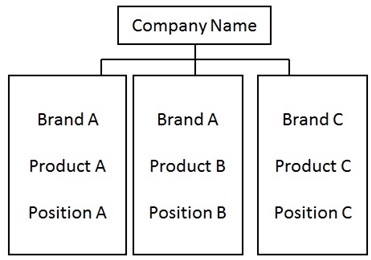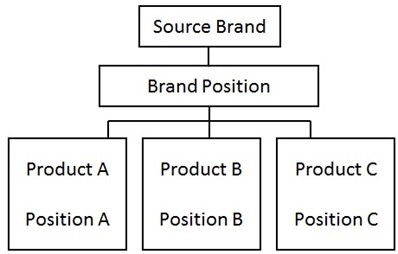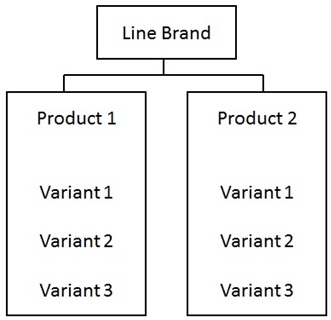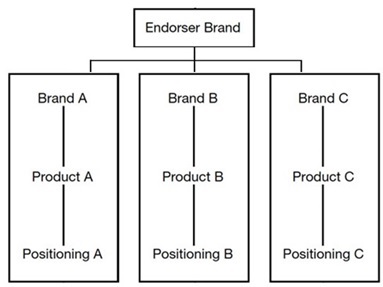
- Inside Brand Management
- Brand Management - Equity
- Brand Management - Equity Models
- Brand Management - Architecture
- Brand Identity and Positioning
- Brand Management - Promotion
- Brand Management - Extension
- Brand Management - Co-branding
- Maintaining The Brand
- Brand Management - Performance
- Brand Management - Leveraging
- Brand Management - Valuation
- Brand Management Resources
- Brand Management - Quick Guide
- Brand Management - Useful Resources
- Brand Management - Discussion
Brand Management - Architecture
When the company portfolio is growing, the brands tend to evolve. It is critically important to define the structure of the brands within a portfolio to keep the brand health strong.
The brand managers need to take various decisions such as considering the right time to extend the existing brand, selecting appropriate brand name, whether or not to have different websites for multiple brands and so on. Since each of such decisions has direct implications on the future, a plan for brands is developed to provide clarity to the consumers.
Brand architecture comes in play while presenting the brand efficiently. Let us learn more about brand architecture.
What is Brand Architecture?
It is the structure of the brand in an organizational entity that defines how various brands and sub-brands in a companys portfolio are related to each other or are different from one another.
Brand architecture provides a hierarchy that depicts the roles and relationships within the products and services that make a companys portfolio and makes sure that the external stakeholders understand the value of what the brands offer.
Types of Brand Architectures
They can be varied from pure to hybrid. However, generally brand architecture is distinguished into two categories − House of brands and Branded house.
| House of Brands | Branded House |
|---|---|
|
Product Brand Range Brand Line Brand Endorsing Brand Umbrella brand |
Source brand Master brand |
|
Multiple brands or activities are brought together under a single name. There is complete freedom for the management of divisions, activities and the brands. For example, Mitsubishi Motors division and Mitsubishi Electricals division are completely unrelated except the fact that they come under Mitsubishi business. Both divisions manage their own advertising, and brand values, and obtain separate profits. |
It is a family of brands with high degree of unity. Here, the master brand structures the child brands in such a manner that they are capable of expressing the value of a parent brand. Master brand is the single brand acting as a driving force. For example, Google. Google books, Google maps, Google Translate, Google Mail, etc., all come under the master brand Google and only differentiate in their descriptions. |
Let us see the brand architecture strategies in detail −
Product Brand Architecture
The brand is a kind of product brand, if the corporate brand name is hidden and every product is assigned a different name and one single positioning. Each new product is a new brand.

Source Brand Architecture
In this type, the company name is well known and guarantees the quality of the products. For source brand, the products are on the forefront, while the company name remains in the background.

Line Brand Architecture
When a variant is added to the existing brand, it is called line extension. The variant can be anything from color, packaging, nutritional value addition, or a new shape. Line brand targets a subset of the consumers.

For example, Cadbury Bournville comes in three flavors − Raisin & Nut, Rich Cocoa, and Cranberry. Likewise Dairy Milk Silk comes in Orange Peel, Roast Almond, and Fruit & Nut variants.
Masterbrand or Monolithic or Umbrella Architecture
This is the simplest type, where all units and divisions of a business share the same brand. The brand name is used for different but related products. It involves creating a brand equity for a single brand. It is also referred to as Corporate, Umbrella, or Parent brand. In this type, the product or service benefits are less important than brand promise. It drives purchase decisions and defines consumer experience.
Endorser Brand Architecture
Here, a parent brand consists of various operating units which are identified by their own brands. The parent endorses the products or services under itself and has a clear market presence. There is a synergy between the product name and the parent name. This architecture provides credibility, approval, and guarantee to another brand.
For example, Marriot Residence Inn, Courtyard, and Fairfield Inn.

Portfolio Brand Architecture
In this type, all or many brands are kept with separate identities, names, and life cycles of their own. They often compete with each other. The parent does not provide any brand equity to benefit the sub-brands. This structure is found in FMCG companies.
Ingredient Brand Architecture
In this architecture, a principle brand supports to qualify other brands. The idea is, if the ingredient is good, it amplifies the brands better than they would have amplified independently without the ingredient. Thus, the ingredient brands turn out as energizer.

For example, Intel Inc. Any computer brands ad says Intel Inside, depicting Intel processor enabled motherboard that comes with high power and speed of execution.
Hybrid Brand Architecture
It is a combination of monolithic, endorsement, and portfolio architectures. These are the most common solutions.
Brand architecture needs to be revised when the companies change their strategies or the business has added important features which are beyond the existing brand structure.
Choosing Appropriate Branding Strategy
The following parameters should be considered while choosing an appropriate branding strategy −
- Marketing strategy
- Business model
- Culture
- Speed of innovation
- Added-value lever on which the product is based
- Brand vision
Internationalizing the Architecture of the Brand
Since most of the brand architectures are built over a substantial period of time in the domestic market, there are some all-time questions while launching the brand on the global canvas −
Should the brand architecture be globalized?
Can the present brand architecture be taken to the new potential countries?
How to handle internationalizing of brand architecture in different countries when there is difference in their respective infrastructure, civic rules and regulations, media costs, to name a few?
For instance, it is definite that taking a brand architecture to Russia could be smoother than taking it to the US as the media and distribution costs are higher in the US.
Classic Branding Dysfunctions
If a brand architecture is not proper, it can lead to unwelcome consequences. Few instances are as follows −
Daughter Brand Swallows Parent Brand
When there are too many daughter brands, the parent brand loses the focus. In the bargain of achieving recognition for the daughter brand, the parent brand takes a backstep. While launching a daughter brand, it gets peoples attention and the daughter brand attracts all the investment on the advertisement. It gets remarkably successful thereby taking over the image of the parent brand. The solution to this is, turn daughter brand into a simple product.
For example, Golf, the daughter brand of Volkswagen swallowed it up in image. Amul Lite, a daughter brand is swallowing parent brand Amul butter due to increased health-consciousness of consumers.
Weakening of Company - Product Connection
The company makes innovative products or makes improvements in the existing product. When a superior product comes up, it is time to decide for the brand managers whether to extend the new product as a part of the original brand or launch it as a new product with a potential of becoming a brand in itself.
While branding the new product out of innovation, the connection between the product and the company that develops it should not be weakened.
How to Name a New Product?
The company grows by bringing out the best in its product. Every time a research and development team comes up with the innovative product, the brand managers have to decide on what to name that new product.
For example, a cement manufacturing company came up with an innovative cement that provides extremely smooth surface. Before introducing it into the market, brand managers need to be decide what to name the product. Is it fine to extend the name just as new ultra smooth cement from? Or should it be given a name that can stand as a brand in itself later?
Brand name is the mightiest form of its identity. It tells the objective of the program and reveals brand intentions. Some brand names and products apparently seem irrelevant.
As in case of Apple, the microcomputers brand, Steve Jobs and the co-founder Steve Wozniak chose this name with the logo of a munched apple as they intended to give a new look to the conventional human-machine relationship. The apple logo tells that a computer machine is something to enjoy, rather than to fear about. Similarly, Amazon logo with a directed arrow from a-to-z depicts range, continuity, strength, and uninterrupted flow.
Thus, to make a strong brand, almost any name can be chosen, with the fact that the brand managers need to put consistent efforts in making the brand name meaningful.
Brand name is not a product. Hence while selecting brand name for a new product, the names which differentiate the product among its competitors must be chosen instead of those that describe what the product does.
Group and Corporate Brands
Instead of working behind a logo or a brand name, the companies have started coming up as brands themselves called corporate brands. They are choosing to become as widely visible as possible out of the consumers demand of responsibility and transparency.
By presenting itself under corporate brand profile, the companies can attract students and executives in the employment market. In Asia, at the end of Procter and Gamble television ad, company signature is displayed for a few seconds as it is already visible and established as a corporate brand. In the US the P&G experience is different and it needs efforts to make itself more visible.
Corporate Brands over Product Brands
Few companies have preferred to keep their own names separate from their brand names for the reason of getting affected in case of brand failure. There are other reasons of corporate visibility over product visibility. The multi-brand retailers, hyper chains are interested in corporate visibility of a company rather than product brands they sell as their basic B2B relation is with companies and not with brands.